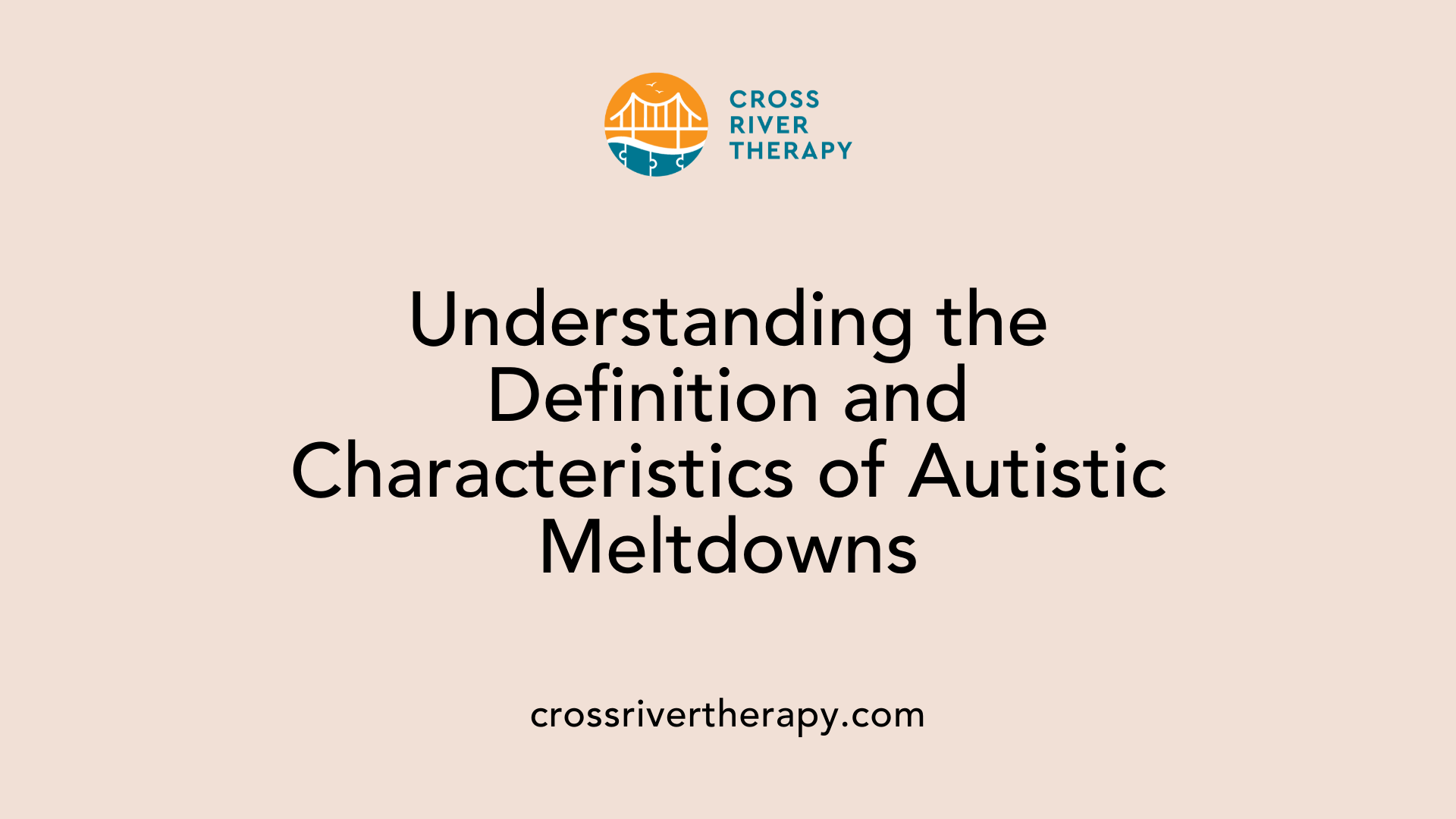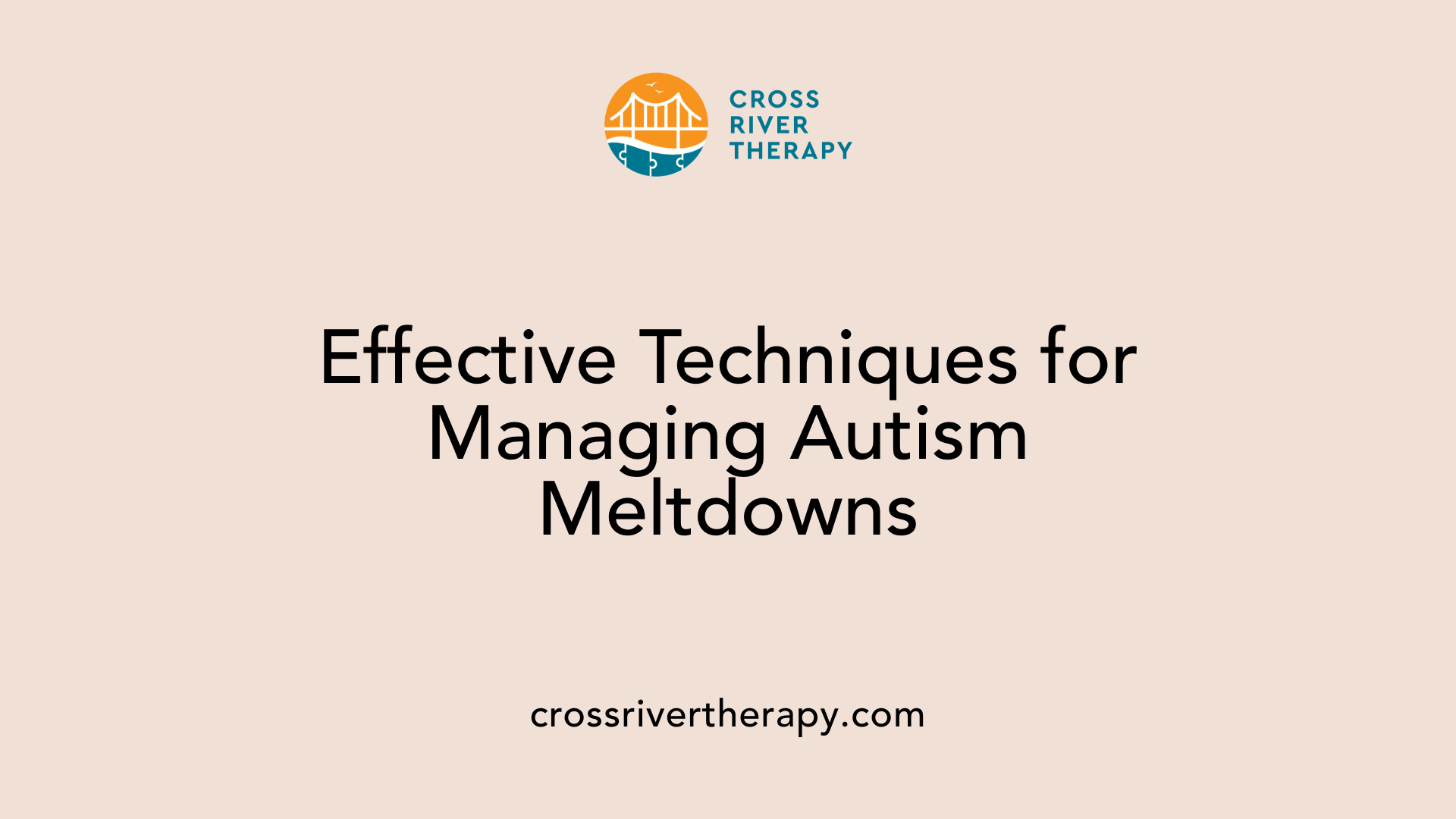Managing Autism Meltdowns Effectively
Understanding and Managing Autistic Meltdowns: A Comprehensive Guide
Introduction to Autism Meltdowns
Autism meltdowns represent a significant challenge for individuals on the autism spectrum, their families, and caregivers. Unlike temper tantrums, meltdowns are involuntary responses to overwhelming circumstances and can manifest as distressing emotional or physical behaviors. This article aims to explore the depth and breadth of these experiences, distinguishing them from tantrums, identifying their stages, and offering practical strategies for managing and reducing their frequency.
What is an Autistic Meltdown?

Definition and Characteristics of Autistic Meltdowns
An autistic meltdown is an intense reaction caused by overwhelming emotional or sensory input. It is an involuntary response where the individual may exhibit behaviors such as crying, shouting, or physical aggression.
These meltdowns can lead to a temporary loss of control, often leaving individuals feeling exhausted afterward. Common physical sensations during a meltdown can include tension, difficulty breathing, and feelings of heat. The duration of these episodes can vary but typically lasts from several minutes to an hour or more.
Differentiation from Tantrums
Meltdowns differ significantly from tantrums. While tantrums are usually goal-oriented behaviors designed to manipulate a situation (such as getting attention or a desired item), meltdowns occur as a direct consequence of sensory overload or emotional distress. The former is a deliberate act; the latter is a reaction beyond the individual's control.
Common Triggers
Triggers for meltdowns can be diverse. Some of the most common include:
- Sensory Overload: Excessive noise, bright lights, or overwhelming crowds.
- Routine Changes: Sudden alterations in daily schedules or environments.
- Communication Difficulties: Inability to express needs or feelings effectively.
- Emotional Stress: Psychological demands and social pressures.
Recognizing these triggers is crucial for parents and caregivers in order to develop proactive strategies that can help minimize the occurrence of meltdowns, fostering a safer and more comfortable environment for autistic individuals.
Identifying the Stages of a Meltdown

What are the stages of an autism meltdown?
Understanding the stages of an autism meltdown is crucial for effective intervention. The process typically involves six distinct phases:
Calm: In this initial phase, individuals may appear serene. Educators and caregivers can implement strategies like adjusting the environment and using visual supports to maintain composure.
Triggers: This phase highlights the identification of specific sensory triggers or environmental factors leading to distress. Modifications should be made to decrease these triggers—a vital step in avoiding meltdown escalation.
Agitation: Signs of increased anxiety or discomfort become evident. Individuals may exhibit certain behaviors such as pacing, fidgeting, or expressing frustration, indicating that a meltdown may be imminent.
Meltdown: This is when the individual loses control, potentially resulting in behaviors like screaming, hitting, or crying. During this intense phase, interventions should focus on ensuring safety and minimizing stimuli.
Re-Grouping: After the peak of a meltdown, individuals usually enter a state where they require time and space to regain self-regulation. Here, emotional support is key, paired with calming techniques like deep breathing or sensory tools.
Starting Over: This final phase allows individuals to return to a state of normalcy and learning. Encouraging gradual re-engagement with activities can help facilitate a smooth transition back to routine.
How meltdowns unfold
It's essential to recognize that meltdowns can develop gradually. Early intervention during the calmer phases can be effective in preventing progression to more extreme behaviors.
Strategies to mitigate escalation
Proactive strategies are invaluable in managing and mitigating meltdowns. Awareness of the individual's triggers, consistent routines, and the use of sensory toolkits can significantly decrease the frequency and intensity of meltdowns. Creating a supportive environment fosters emotional regulation and resilience against overwhelming sensory input.
Recovery from an Autistic Meltdown

How long does it take to recover from an autistic meltdown?
Recovery from an autistic meltdown can vary widely, lasting anywhere from a few minutes to several days. The intensity of the meltdown and the individual's personal circumstances play a significant role in this timeframe. Factors such as preceding sensory overload or extreme stress can prolong recovery time. Caregivers should create a calm and supportive environment, allowing the individual ample space and time to de-stress instead of pushing for a quick recovery.
Strategies to support recovery
Engaging individuals in calming activities can significantly aid in the recovery process. Activities like using sensory toys, listening to soothing music, or participating in a favorite hobby can help restore a sense of normalcy. Open communication is also key; discussing feelings and experiences after the person has calmed down can improve understanding and pave the way for better coping strategies in the future. It's advantageous for caregivers to monitor their own emotional wellbeing; supporting someone during a meltdown can be taxing.
Environmental adjustments
Making environmental adjustments is essential for recovery. A quiet, dimly lit space can minimize overstimulation and facilitate a smoother recovery. Reducing external noise and using familiar, comforting items, such as weighted blankets or soft toys, can also create a safe atmosphere conducive to regaining control. This proactive approach helps individuals feel more secure and understood, decreasing the likelihood of future meltdowns.
Handling Autism Meltdowns

How do you handle autism meltdowns?
Handling autism meltdowns involves a proactive approach to recognizing triggers and early signs of distress. Observing behaviors during the 'rumble stage,' such as pacing or rocking, can provide critical opportunities for intervention. Effective immediate strategies include offering comforting distractions, like fidgets or calming visual aids, and engaging in calming activities that help redirect focus.
Creating a supportive environment is essential for recovery after a meltdown. Reducing sensory overload can be particularly beneficial; this might involve dimming lights, reducing noise, or finding a quiet space where the child can regain control. Safety is paramount, so ensure that the immediate environment is free from potential hazards.
Adapting communication techniques also plays a crucial role in managing meltdowns. Using clear, concise language and visual supports can help convey expectations and reduce frustration during overwhelmed states. For instance, visual schedules can assist with transitions, providing predictability that many autistic individuals thrive on.
Remaining calm during a meltdown cannot be overstated. Your composed demeanor can influence the child’s emotional state positively, assisting them in finding balance more quickly. Practicing these strategies regularly can provide both caregivers and autistic individuals with the tools needed to navigate meltdowns more effectively.
Differences in Autism Meltdowns: Children vs. Adults
How can autistic meltdowns differ between children and adults?
Autistic meltdowns manifest differently across age groups, influenced by emotional regulation and environmental factors.
Children are often more susceptible to frequent meltdowns driven by sensory overload or changes in routine. They may express their meltdowns through loud outbursts, crying, or physical acts like kicking, reflecting their limited coping skills. In contrast, adults typically encounter meltdowns less frequently, but with heightened intensity. This can lead to more complex behaviors such as withdrawal or severe emotional distress, particularly when linked to chronic stress or burnout.
Triggers and manifestations in different age groups
The roots of meltdowns can vary. For children, triggers are often immediate, such as a sudden noise or disruption in routine. Adults, however, may experience meltdowns due to accumulated stress, culminating in emotional crises that might be harder for others to identify.
| Age Group | Common Triggers | Manifestations |
|---|---|---|
| Children | Sensory overload, routine changes | Crying, aggression, physical outbursts |
| Adults | Chronic stress, communication difficulties | Emotional withdrawal, anxiety, aggression |
Social misconceptions
Misunderstandings about meltdowns can lead to prejudice against individuals of all ages. Adults often face skepticism from society, which might wrongly perceive their meltdowns as signs of poor emotional control or manipulative behavior, hindering support and understanding. Meanwhile, children usually receive empathetic responses from caregivers but might struggle with feelings of shame and confusion post-meltdown.
Impact of stress and burnout in adults
For adults with autism, meltdowns are often intricately linked to sustained stress and burnout. As they navigate societal expectations and sensory challenges, the cumulative pressure can lead to overwhelming experiences, resulting in involuntary meltdowns. In this context, understanding and support are critical for minimizing the risk of these occurrences.
Pre-Meltdown Signs: Recognizing the 'Rumble Stage'
What are early warning signs of an imminent meltdown?
Recognizing early warning signs is crucial in managing meltdowns effectively. Early signs of a potential meltdown can manifest in several ways:
- Stimming behaviors: These include repetitive movements such as rocking or hand-flapping.
- Increased agitation: A heightened state of restlessness or irritability may be observed.
- Desire to escape: The child may show a wish to distance themselves from overwhelming environments.
- Heightened anxiety: Signs of distress can emerge, often characterized by visible fear or worry.
- Communication difficulties: The child may struggle to articulate their feelings or withdraw from conversations.
By being aware of these indicators, caregivers can intervene early, offering opportunities for distraction, or removing triggers that may lead to escalation.
Importance of early intervention
Understanding the significance of early intervention is paramount. When signs of distress are spotted, responsive measures can help in de-escalating tension. This proactive approach fosters a safer environment and can significantly reduce the incidence of full meltdowns.
Preventative strategies
Employing preventative strategies can also be beneficial. Here are several effective methods:
- Visual supports: Implement visual schedules and cues to communicate expectations clearly.
- Quiet spaces: Establish designated calm areas where the child can retreat during moments of overwhelm.
- Regular routines: Consistent daily schedules minimize unexpected changes that might trigger a meltdown.
By leveraging these strategies, caregivers can better support autistic individuals in navigating their environments, reducing the likelihood of meltdowns before they occur.
Developing an Effective Meltdown Prevention Plan
Understanding and Managing Sensory Sensitivities
Recognizing and addressing sensory sensitivities is crucial for preventing meltdowns. This begins with understanding what specific sensory inputs might trigger discomfort in an autistic individual, such as loud noises, bright lights, or even specific textures. Developing a sensory diet including calming activities, such as deep pressure from a weighted blanket or tactile fidget toys, can help in managing these sensitivities throughout the day.
Creating Consistent Routines
Structured and predictable routines provide a sense of safety for autistic children. Preparing them for daily activities with visual schedules and routine charts clarifies what to expect, reducing anxiety levels. Additionally, discussing any potential changes in routine ahead of time allows children to mentally prepare, thereby fostering resilience against unexpected transitions.
Emotional Regulation Tools and Strategies
Equipping autistic children with emotional regulation tools enhances their ability to manage their feelings before they escalate to a meltdown. Techniques such as breathing exercises, muscle relaxation, or engaging in visualization can help them calm their nervous systems. Encouraging mindfulness and facilitating moments of self-reflection through calm conversations afterward can further develop their coping strategies.
Summary of Strategies to Prevent Autism Meltdowns
| Area | Strategies | Tools |
|---|---|---|
| Sensory Sensitivities | Identify triggers, create sensory diet, use fidget toys | Weighted blanket, noise-canceling headphones |
| Consistency in Routine | Visual schedules, advance notice of changes, discuss daily plans | Routine charts |
| Emotional Regulation | Breathing exercises, mindfulness practices, social stories, and discussions | Calm-down spaces, sensory kits |
Preventing autistic meltdowns involves understanding individual triggers, employing supportive strategies, and consistently maintaining routines.
Essential Tools and Kits for Meltdown Management

What should a meltdown kit include?
An effective meltdown kit should be tailored to the child's preferences and include several essential items. For managing auditory sensitivities, include noise-canceling headphones, which can reduce overwhelming sounds in noisy environments. Fidget toys can also be added for tactile stimulation, allowing the child to engage with a familiar and calming object.
Weighted blankets provide proprioceptive feedback, helping to ground the child and create a sense of security. These tools are crucial for managing sensory overload and promote self-soothing not only during a meltdown but also during times of heightened anxiety.
Additionally, incorporating visual cards or a favorite book can help facilitate distraction and calmness when a child feels overwhelmed. Such kits are especially useful in public spaces or other high-stimulus environments, where children may struggle the most. They serve to empower the child, allowing them to take control of their coping strategies.
Portable sensory tools
Beyond the meltdown kit, several portable sensory tools can support children during transitions or outings. Items like weighted lap pads can provide immediate comfort, while fidget spinners or stress balls allow for quick sensory engagement when anxiety starts to rise. Having these tools available encourages the child to manage their responses to stress immediately, contributing to prevention strategies.
Role of therapeutic interventions
Incorporating therapeutic interventions, such as Applied Behavior Analysis (ABA) therapy, can significantly enhance a child's ability to navigate their sensory experiences. These interventions teach valuable emotional regulation and communication skills, reducing the frequency and intensity of meltdowns.
Collaborating with therapists to develop personalized strategies that can be used in real-life situations can enhance the effectiveness of the meltdown kit. Parents play a crucial role in reinforcing these learned strategies within everyday contexts, ensuring that children feel supported both at home and in public.
Role of Caregivers and Educators in Managing Meltdowns
Creating a Supportive Environment
A supportive environment is crucial for preventing meltdowns in autistic children. Caregivers and educators can create these environments by introducing calming spaces, reducing sensory overload, and providing structure through routines. A quiet area stocked with comforting items can offer a refuge during stressful moments, while ensuring that the child has access to sensory tools like fidget toys and weighted blankets can help ease anxiety.
Training and Educational Resources
Training for both caregivers and educators is vital. Workshops focusing on autism awareness, teaching coping strategies, and understanding sensory triggers can empower caregivers with the knowledge needed to effectively support children during meltdowns. Resources like social stories and behavior logs can help track triggers and prepare children for various situations, which is instrumental in managing their responses.
Consistent Approach in Different Settings
Establishing a consistent approach across different environments is essential. Educators can strengthen communication with parents to maintain aligned strategies at home and school. By collaboratively creating personalized support plans based on Behavioral Assessments, educators can ensure a unified understanding of each child's unique needs. This consistency helps build a reliable framework for the child, reducing the chance of sensory overwhelm and meltdowns.
Resources for Managing Autism Meltdowns
What resources are available to help manage autism meltdowns?
Numerous resources exist to aid in managing autism meltdowns. Applied Behavior Analysis (ABA) therapy is one of the most effective methods, focusing on teaching emotional regulation and communication skills. This therapy helps children learn to express their feelings in healthier ways, reducing the frequency of meltdowns over time.
Furthermore, community support groups provide invaluable resources for parents and caregivers. These groups create a safe space to share strategies, experiences, and the emotional challenges of raising a child with autism. Participants often share practical tips on managing meltdowns based on personal experiences, making it a rich source of information and support.
Additionally, various educational materials are available online and in libraries. These materials cover techniques for handling meltdowns, effective behavior plans, and sensory management strategies, based on the latest research in autism education.
Engaging with local autism advocacy organizations is also beneficial. These organizations often host events, workshops, and training sessions that improve awareness and understanding of autism, enabling parents and caregivers to enhance their support networks. Such resources collectively equip individuals facing autism meltdowns with crucial tools and support.
Effective Strategies for Navigating Autism Meltdowns
Managing autism meltdowns effectively requires a comprehensive understanding of individual needs, recognition of early warning signs, and implementation of personalized strategies. Providing consistent support through adjusted environments, tailored tools, and educational resources is crucial. By equipping caregivers, educators, and the autistic individuals themselves with knowledge and skills, meltdowns can become more manageable, reducing their frequency and intensity. As understanding grows, so too does the ability to navigate these challenging yet surmountable experiences, leading to more fulfilling interactions and a supportive community. This ultimately ensures a more inclusive world for everyone involved.
References
- Managing Autism Meltdowns, Tantrums and Aggression
- Meltdowns - a guide for all audiences - National Autistic Society
- Meltdowns: autistic children & teenagers | Raising Children Network
- Meltdowns & Calming Techniques in Autism
- All About Autistic Meltdowns: A Guide For Allies - Reframing Autism
- Autism Meltdowns: Causes, Signs, and Strategies for Support
- 10 Tips for De-Escalating Autism Sensory Meltdowns - Angel Sense



